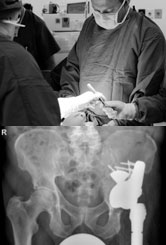Revision Hip Replacement, Oxford
Most patients will do excpetionally well from their hip replacement - to remind you, a hip replacement is a mechanical device with parts that are assembled before and during the operation, most commonly referred to as a “ball and socket.” After surgery, the prosthetic ball and socket restore movement in the hip during the life-span of the prosthesis.
However, as with any other mechanical device, a total hip replacement can be subject to various forms of mechanical or biological failure. Some of these conditions may require a re-operation of the hip replacement to address the cause of failure and its consequences and this operation is called a “revision.”
The majority of elderly patients who receive a hip replacement will find that their prosthesis lasts for 15 to 20 years, and sometimes, if they are fortunate, for life. However, some patients may need one or more revisions of a hip replacement, particularly if the initial hip replacement surgery is performed at a young age and the patient chooses to have a very active physical lifestyle.
Pre-operative investigations in patients who will undergo revision surgery are more in depth than those required in patients scheduled for the first surgery. Mr Whitwell may request special x-rays, CT scans or an MRI scan of the hip to determine position and fixation of the replacement parts (components), and to determine with precision the extent of bone loss around the failed implant. A preoperative aspiration (fluid sample) and/or special blood work may be needed ifMr Whitwell suspects an infection in the failed hip.
Revision hip replacement is a relatively uncommon operation. In the UK, there are approximately 15 revision hip replacements performed for every 100 hip replacements. The most frequent reasons for revision are:
a. repetitive dislocation of a hip replacement
b. mechanical failure (implant wear and tear – loosening - breakage)
c. infection
Repetitive (Recurrent) Hip Dislocation
As discussed above, a hip replacement has a structure that resembles that of a natural hip (a ball and socket). For a hip replacement to function well, the ball has to be inside the socket at all times. The factors keeping the ball inside the socket are the alignment and fit of the ball and the socket, and the forces generated by the strong muscles and ligaments around the hip joint. A hip replacement is designed to have a large range of motion. However, some hip positions or trauma can force the hip ball out of the socket, a condition referred to as dislocation.
Dislocations are relatively uncommon, particularly in the healthy patient who carefully follows precautions given by Mr Whitwell and our team of expert physiotherapists. However, some patients are predisposed to this complication: the elderly, debilitated patients, or those who have a hip replacement following a hip fracture or after multiple hip previous hip surgery.
Patients who suffer a hip dislocation are more prone to further hip dislocations, as the dislocated ball disrupts the important muscles and ligaments around the hip. Multiple dislocations are infrequent, but in patients who have suffered multiple hip dislocations, Mr Whitwell may recommend revision surgery.
Revision surgery is effective in preventing a new dislocation. Prior to surgery, Mr Whitwell may request additional x-rays and scans to determine the exact position and orientation of the different parts of the replacement. One or more parts may need to be replaced during the revision.
In certain instances, Mr Whitwell may use a device that “captures” the ball inside the socket (called a constrained socket). The proper healing of the soft tissues around a revised hip is most important for the success of the operation. Therefore, Mr Whitwell may recommend wearing a brace for a few weeks after surgery. After surgery, it is important to follow his advice and to not move the hip into positions that can generate a new dislocation.
Mechanical Wear, Implant Loosening, and Breakage
The mobile parts of a hip replacement that move against each other will gradually wear during the day to day use of the replacement. The younger and the more physically active the patient is, the faster the wear. The wear consists of the generation of very small particles from constant, repetitive movement of the mechanical parts during use of the hip. Depending on the type of hip replacement, the particles can be made out of plastic, cement, ceramic, or metal.
The patient’s immune system may recognise those particles as foreign and generate an immune response (like an allergic reaction). A strong reaction to the wear particles can result in the destruction of bone around the hip replacement (a condition called osteolysis). If the bone destruction is severe enough, the components of the replaced hip may become loose.
During revision surgery for wear, mechanical loosening, or breakage, Mr Whitwell will remove the worn/loosened/broken component/s, will assess the amount of bone loss, and will implant new components. Frequently, a bone graft (cadaveric bone from tested donors) is necessary to rebuild the bone content of the hip lost during the process of prosthetic failure. In certain instances Mr Whitwell may ask the patient not to bear full weight in the operated leg for a period of time after surgery.
Infection of a Hip Replacement
Infection of a hip replacement can occur at any time after surgery. The risk is higher for the first few weeks after surgery. However, after that, there is a low risk of “late” infections. Sometimes, infections in the mouth, gums, teeth, lungs, urine, or skin, or regular dental procedures that involve gum bleeding, can force bacteria in the blood stream. The bacteria can seed and infect a hip replacement, causing hip pain and the patient to become systemically unwell.
In the presence of a prosthetic infection, Mr Whitwell will try to identify the organism (bacteria) that is causing the infection. He may recommend a hip aspiration. The liquid aspirated from the hip will be sent to the laboratory and tests performed to determine the type of bacteria present and the antibiotics the bacteria are sensitive to.
Once an infection in the hip replacement has been diagnosed, several treatment options are possible. Unfortunately, nearly always, surgery is required and a course of antibiotics specifically targeting the infecting bacteria. The treatment option depends on the type of bacteria, the sensitivity to antibiotics, the duration of the infection, the fixation of the hip replacement parts, and the patient’s general condition. The surgeon will discuss benefits and drawbacks of each treatment option.
Most commonly we will:
a. Surgically clean the hip replacement. This is generally recommended when the infection is discovered very early (within a few hours or days). Patients require six weeks of intravenous antibiotics and, frequently, a low dose of oral antibiotics for a long period of time (sometimes for life).
b. An exchange of the components in two stages; A first stage consists of the complete removal of the hip replacement, cleaning of the bone, and implantation of a temporary cement spacer that will allow some hip motion and deliver antibiotics to the hip area. This is generally followed by a six week course of intravenous antibiotics. The second stage consists of the re-implantation of a definitive hip replacement (generally 6 to 8 weeks after the initial operation).
c. A complete exchange of a hip replacement done as a single operation, during which the infected prosthesis is removed, the bone is cleaned, and a new prosthesis is implanted. Patients require six weeks of intravenous antibiotics and, frequently, a low dose of oral antibiotics for a long period of time (sometimes for life).
The importance of awareness and postoperative surveillance: Some of the previously mentioned forms of failure can be prevented.
Dislocations can be prevented by following Mr Whitwell's instructions; some forms of hip infection can be prevented by prompt treatment of other infections and by taking antibiotics before certain dental and other procedures.
During revision surgery, the Mr Whitwell may need to remove or exchange one or more parts of the hip replacement. The parts that are not attached to the bone can be safely exchanged with minimal to no removal of the patient’s bone. However, if the metallic parts in contact with the bone need to be changed, some bone loss generally occurs. In addition, some of the musculature around the hip will be lost, thus affecting the strength of the hip and the patient’s function after surgery. The results of revision surgery are not as predictable as those of the primary surgery.
A revision of a hip replacement is generally more challenging than the initial operation. The results of surgery and the lifespanof the revised hip replacement are less predictable than those of the primary operation. With every revision hip operation, there is some loss of muscular mass, bone, or both. The duration of surgery is generally longer and the likelihood of complications higher than during the primary surgery.
Oxford Hip & Knee Surgery Navigation

Latest News
Mr. Whitwell is the chair and convenor of the Oxford Musculoskeletal Oncology Review 2012.>> read more


